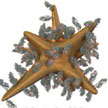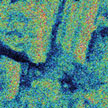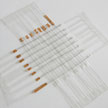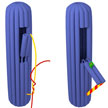Showing Spotlights 1281 - 1288 of 2875 in category All (newest first):
 Nanocellulose from wood is a promising nanomaterial with potential applications as a substrate for printing electronics, filtration, or biomedicine. Researchers have now reported on a method to control the surface chemistry of nanocellulose. They fabricated nanocellulose gels that have a significantly higher swelling degree in neutral and alkaline conditions, compared to an acid environment. This material could be of great interest for critical wound healing applications.
Nanocellulose from wood is a promising nanomaterial with potential applications as a substrate for printing electronics, filtration, or biomedicine. Researchers have now reported on a method to control the surface chemistry of nanocellulose. They fabricated nanocellulose gels that have a significantly higher swelling degree in neutral and alkaline conditions, compared to an acid environment. This material could be of great interest for critical wound healing applications.
Apr 10th, 2014
 Nanomaterials for nanomedicine and biological applications are often two-component structures - referred to as 'nanoconstructs' -consisting of a 'hard' nanoparticle core and a 'soft' shell of biomolecular ligands. Researchers have now demonstrated a nanoconstruct with enhanced in vitro efficacy. This highly loaded nanoconstruct was taken up by pancreatic cancer cells and fibrosarcoma cells at fast rates. The team found that the increased loading of Apt on AuNS also resulted in an enhanced in vitro response.
Nanomaterials for nanomedicine and biological applications are often two-component structures - referred to as 'nanoconstructs' -consisting of a 'hard' nanoparticle core and a 'soft' shell of biomolecular ligands. Researchers have now demonstrated a nanoconstruct with enhanced in vitro efficacy. This highly loaded nanoconstruct was taken up by pancreatic cancer cells and fibrosarcoma cells at fast rates. The team found that the increased loading of Apt on AuNS also resulted in an enhanced in vitro response.
Apr 9th, 2014
 Researchers have proposed an alternative way of making graphene from rice husk. This research, using an ordinary synthetic apparatus and abundant agricultural waste, suggest that low cost graphene materials could now be easily and cheaply synthesized on an industrial scale. Due to its abundance, risk husk has already received much attention as a starting material in generating high-value-added materials such as silica and porous carbon.
Researchers have proposed an alternative way of making graphene from rice husk. This research, using an ordinary synthetic apparatus and abundant agricultural waste, suggest that low cost graphene materials could now be easily and cheaply synthesized on an industrial scale. Due to its abundance, risk husk has already received much attention as a starting material in generating high-value-added materials such as silica and porous carbon.
Apr 7th, 2014
 Scientists have great expectations that nanotechnologies will bring them closer to the goal of creating computer systems that can simulate and emulate the brain's abilities for sensation, perception, action, interaction and cognition while rivaling its low power consumption and compact size - basically a brain-on-a-chip. Already, scientists are working hard on laying the foundations for what is called neuromorphic engineering - a new interdisciplinary discipline that includes nanotechnologies and whose goal is to design artificial neural systems with physical architectures similar to biological nervous systems.
Scientists have great expectations that nanotechnologies will bring them closer to the goal of creating computer systems that can simulate and emulate the brain's abilities for sensation, perception, action, interaction and cognition while rivaling its low power consumption and compact size - basically a brain-on-a-chip. Already, scientists are working hard on laying the foundations for what is called neuromorphic engineering - a new interdisciplinary discipline that includes nanotechnologies and whose goal is to design artificial neural systems with physical architectures similar to biological nervous systems.
Apr 4th, 2014
 New solar cell technology allows your T-shirt to generate power from its interwoven solar cell wires. Researchers have developed a novel efficient wire-shaped polymer solar cell by incorporating a thin layer of titania nanoparticles between the photoactive material and electrode. An aligned carbon nanotube fiber enabled high flexibility and stability of the resulting polymer solar cell. These miniature polymer solar cell wires, when woven into textiles, can serve as a power source.
New solar cell technology allows your T-shirt to generate power from its interwoven solar cell wires. Researchers have developed a novel efficient wire-shaped polymer solar cell by incorporating a thin layer of titania nanoparticles between the photoactive material and electrode. An aligned carbon nanotube fiber enabled high flexibility and stability of the resulting polymer solar cell. These miniature polymer solar cell wires, when woven into textiles, can serve as a power source.
Apr 3rd, 2014
 Not to be confused with the nanorobots of science fiction, for medical nanotechnology researchers a nanorobot, or nanobot, is a popular term for molecules with a unique property that enables them to be programmed to carry out a specific task. In what is the smallest 3D DNA origami box so far, researchers in Italy have now fabricated a nanorobot with a switchable flap that, when instructed with a freely defined molecular message, can perform a specifically programmed duty. Slightly larger nanocontainers with a controllable lid have already been demonstrated by others to be suitable for the delivery of drugs or molecular signals, but this new cylindrical nanobot has an innovative opening mechanism.
Not to be confused with the nanorobots of science fiction, for medical nanotechnology researchers a nanorobot, or nanobot, is a popular term for molecules with a unique property that enables them to be programmed to carry out a specific task. In what is the smallest 3D DNA origami box so far, researchers in Italy have now fabricated a nanorobot with a switchable flap that, when instructed with a freely defined molecular message, can perform a specifically programmed duty. Slightly larger nanocontainers with a controllable lid have already been demonstrated by others to be suitable for the delivery of drugs or molecular signals, but this new cylindrical nanobot has an innovative opening mechanism.
Apr 2nd, 2014
 Existing nanofluidic approaches to facilitate the manipulation of ultra-small amounts of liquids usually require their confinement within quasi-1D nanochannels or nanopores. In these devices, the movement of the liquid objects must follow pre-designed routes. Researchers have now demonstrated a new platform for digital nanofluidics where water nanodroplets are trapped between a mica surface and graphene. Here, with the assistance of a graphene protection layer and ice-like lubricant monolayer, water nanodroplets can be moved, merged, separated, and patterned into regular arrays freely within a two-dimensional channel.
Existing nanofluidic approaches to facilitate the manipulation of ultra-small amounts of liquids usually require their confinement within quasi-1D nanochannels or nanopores. In these devices, the movement of the liquid objects must follow pre-designed routes. Researchers have now demonstrated a new platform for digital nanofluidics where water nanodroplets are trapped between a mica surface and graphene. Here, with the assistance of a graphene protection layer and ice-like lubricant monolayer, water nanodroplets can be moved, merged, separated, and patterned into regular arrays freely within a two-dimensional channel.
Mar 31st, 2014
 Concern about the depletion of global water resources has grown rapidly in the past decade due to our increasing global population and growing demand for other diverse applications. Since only 2.5% of the Earth's water is fresh, it has been reported that almost half of the world's population is at risk of a water crisis by the year 2025. Accordingly, significant research efforts have been focused on the desalination of brackish/seawater and the remediation and reuse of wastewater to meet the agricultural, industrial, and domestic water demands.
Concern about the depletion of global water resources has grown rapidly in the past decade due to our increasing global population and growing demand for other diverse applications. Since only 2.5% of the Earth's water is fresh, it has been reported that almost half of the world's population is at risk of a water crisis by the year 2025. Accordingly, significant research efforts have been focused on the desalination of brackish/seawater and the remediation and reuse of wastewater to meet the agricultural, industrial, and domestic water demands.
Mar 27th, 2014
 Nanocellulose from wood is a promising nanomaterial with potential applications as a substrate for printing electronics, filtration, or biomedicine. Researchers have now reported on a method to control the surface chemistry of nanocellulose. They fabricated nanocellulose gels that have a significantly higher swelling degree in neutral and alkaline conditions, compared to an acid environment. This material could be of great interest for critical wound healing applications.
Nanocellulose from wood is a promising nanomaterial with potential applications as a substrate for printing electronics, filtration, or biomedicine. Researchers have now reported on a method to control the surface chemistry of nanocellulose. They fabricated nanocellulose gels that have a significantly higher swelling degree in neutral and alkaline conditions, compared to an acid environment. This material could be of great interest for critical wound healing applications.

 Subscribe to our Nanotechnology Spotlight feed
Subscribe to our Nanotechnology Spotlight feed





